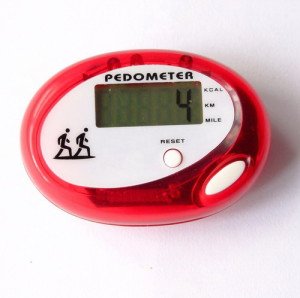Researchers at the University of Pennsylvania School of Medicine have found a way to engineer mice that stay healthy without exercise. The human benefits of this finding are still decades away, so if you want to be healthy while avoiding exercise there is no single solution. However, there are a number of ways to incorporate activity into your lifestyle, so that you do not have to go to the gym. This is not an option for anyone who is overweight or has diabetes or heart disease. People who are already healthy can avoid dedicating extra time for exercise with an active lifestyle and a healthy diet. This article will tell you how to stay fit without exercise.
Method 1 of 2: Healthy Lifestyle Habits
1 Buy a pedometer

This small and inexpensive piece of equipment can tell you how much exercise you already have in your daily schedule. Doctors recommend that you take at least 10,000 steps in a day to be healthy.
If you do not take this many steps in a day, you will need to find ways to be more active in your daily life. If you do not, you may be at risk for weight gain, high cholesterol, high blood pressure and chronic diseases.
2 Walk faster

If you commute, walk the dog, or walk inside stores, do them faster. You will burn more calories, increase your heart rate and save time.
3 Commute by walking or biking, instead of driving in a car

If this is an option, your commute will not only take out the need to go to a gym, it can also release work-related stress and allow you to get more Vitamin D from sunlight. If this is not an option, try to commute in more than 1 way. Take the bus half of the way and walk the rest of the way to work. You can also park 1/2 or 1 mile away from the office, and walk to and from your car.
4 Avoid sitting for longer than 30 minutes at a time

People who sit in a desk for hours are at risk for chronic back pain. You burn 33 percent more calories when standing, and frequent walking around will help to stretch your muscles and improve your posture.
5 Embrace twitching

Although twitching movements are sometimes frowned upon, tapping your fingers, stretching muscles, rolling your eyes, moving your neck and wrists, and frequent standing and pacing can help you to burn more calories and boost your metabolism. Move your legs or arms when you talk on the phone, watch TV or read.
Studies have shown a link between small muscle movements, metabolism and weight control. People who are skinny tend to incorporate more small movements into their daily life. They may not even be aware that they are doing it. Start a habit of moving your body in a way that is not likely to annoy you or others.
6 Breathe deeply

Start a habit to relax, sit back and breathe deep into your diaphragm (chest). Inhale for 1 to 2 seconds and exhale for 2 seconds. Do this for 2 minutes at work, in the car, on the couch, while you are making dinner or before bed.
7 Do your cleaning and household chores

Do your cleaning and household chores in 30 minute to 1 hour intervals. Mopping, scrubbing, dusting, vacuuming, gardening, sweeping, window washing, car washing, raking and other chores qualify as exercise. Plan to break a sweat when you do your chores.
A British survey found that women said they cleaned approximately 2 and a half hours per week. This is approximately the same amount of moderate exercise that is recommended by doctors.
8 Cultivate outdoor hobbies

Even if you hate to exercise, perhaps you like to throw a Frisbee with your dog, play baseball with your children or play basketball with friends. Incorporate socializing into your active hobbies and you are less likely to view them as exercise.
9 Get a dog or walk 1 for someone else

Dogs require walking a few times a day, and longer walks on weekends. Turn this into a chance to get out, run alongside the dog or play fetch games.
Getting a dog is not a matter to be taken lightly. If you already have a dog, think of ways that you can play more with it. If you cannot afford to take care of a dog, see if any neighbors need a dog walker. Many times elderly people with pets cannot take them on long walks or to dog parks to run and play games.
10 Plan active days out

Go bowling, play tag, go bicycling, swimming, dancing, or play active video games with family or friends. Devote several nights and weekends to family or friend activities, rather than watching television or sitting at the computer.
Method 2 of 2: Healthy Diet Habits
1 Avoid sugar and processed foods

If you eat fast food or junk food regularly, it is unlikely that you can stay fit without exercise. These “empty calories” require a lot more activity to burn off, without providing nutritional content to help your immune system or build strong muscles.
2 Eat fruit 2 or more times per day

Fruit contains sugar, but it also contains fiber, which helps to regulate your digestive system. If you feel a craving for sugar, eat a piece of fruit.
3 Make sure 50 percent of all meals consist of vegetables

4 Eat smaller meals throughout the day, rather than 3 big meals

Smaller meals will help you avoid feeling hungry throughout the day. One way to do this is to plan eating larger, healthy snacks between meals and shrink the size of your portions at breakfast, lunch and dinner.
This may be a hard step to undertake if you have a family. Experiment with snack and meal times for yourself, and then suggest it to family members if it is successful.
